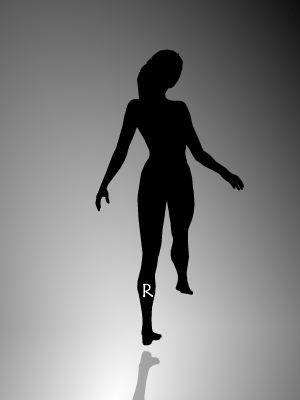The Spinning Dancer
From Wikipedia, the free encyclopedia
The Spinning Dancer, also known as the silhouette illusion, is a kinetic, bistable optical illusion resembling a pirouetting female dancer. The illusion, created by web designer Nobuyuki Kayahara,[1][2] involves the apparent direction of motion of the figure. Some observers initially see the figure as spinning clockwise and some counterclockwise.
The illusion derives from the lack of visual cues for depth. For instance, her arms could be swinging either in front of her to the left or behind her to the left, and hence with her circling clockwise or counter-clockwise on either her left or right foot. She changes leg because she's facing either towards or away from the observer, there being no surface features on the silhouette to indicate at any point which side of her is presented: the least ambiguous positions are her profiles when she's on either side of her circle, though it's still not known whether the foreground or background leg is on the floor, and from where she moves indeterminately either on the near or far arc across to the other profile.
There are other optical illusions that originate from the same or similar kind of visual ambiguity. One example is the Necker Cube.
Contents |
[edit] Psychology of visual perception
The illusion has been incorrectly[3] identified as a scientific personality test that supposedly reveals which hemisphere of the brain is dominant in the observer. Under this unproven interpretation, it has been popularly called the Right Brain–Left Brain test,[4] and was widely circulated on the Internet during late 2007 to early 2008.
[edit] Bistable perception
Depending on the perception of the observer, the apparent direction of spin may change any number of times, although some observers may have difficulty perceiving a change in motion at all. One way of changing the direction perceived is to use averted vision and mentally look for an arm going behind instead of in front, then carefully move the eyes back. Some may perceive a change in direction more easily by narrowing visual focus to a specific region of the image, such as the spinning foot or the shadow below the dancer and gradually looking upwards. One can also try to tilt one's head to perceive a change in direction. Alternate versions of the image exist in which an additional visual cue facilitates the perception of counterclockwise spin and clockwise spin.
|
|||||
[edit] Further analysis
[edit] References
- ^ Nobuyuki Kayahara's website
- ^ Parker-Pope, Tara (2008-04-28). "The Truth About the Spinning Dancer". Well Blog. The New York Times. http://well.blogs.nytimes.com/2008/04/28/the-truth-about-the-spinning-dancer/. Retrieved on 2008-08-07.
- ^ Novella, Steven (2007-10-11). "Left Brain - Right brain and the Spinning Girl". NeuroLogica Blog. http://www.theness.com/neurologicablog/index.php?p=27. Retrieved on 2008-08-07.
- ^ "The Right Brain vs Left Brain test". PerthNow. The Sunday Times. 2007-09-26. http://www.news.com.au/perthnow/story/0,21598,22492511-5005375,00.html. Retrieved on 2008-08-07.





